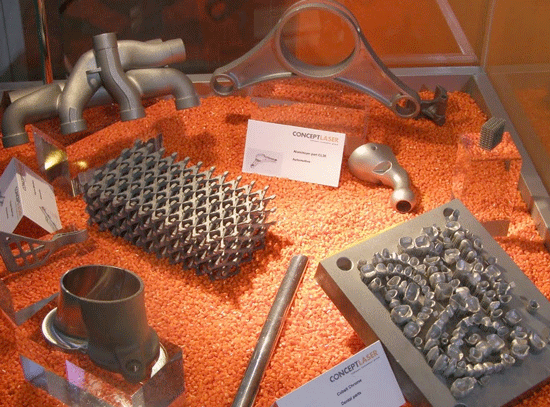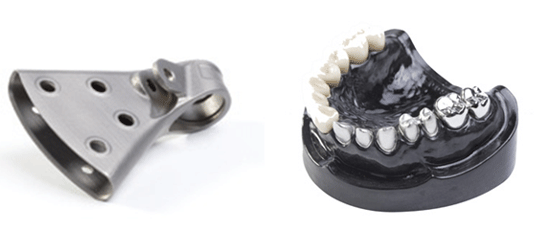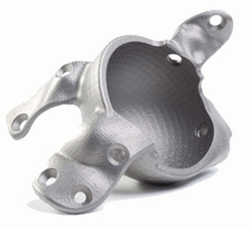Additive Manufacturing – machine builders state their case
In the second of two exclusive reports for ipmd.net, Bernard Williams reports on the additive manufacturing options available from various companies who were exhibiting at the show.
There are a number of variations to the generic term ‘additive manufacturing’ with each machine builder giving their own name to their particular version of the technology. Some of the international companies active in producing equipment for use in ‘additive manufacturing’ exhibited their wares on stands in the Additive Manufacturing section of TCT Live 2011 at the NEC in Birmingham, and these were also given the opportunity to present their latest innovations during seminar sessions within the exhibition.
Rotor made from Nickel-base superalloy
IN718 using EOSINT equipment (Courtesy
Morris Technologies, USA)
Direct Metal Laser Sintering
EOS Electro Optical Systems GmbH, based in Krailling, near Munich, Germany, is probably the largest supplier of equipment for this sector having delivered more than 290 ‘Direct Metal Laser Sintering’ (DMLS) machines worldwide over the past 10 years.
Stuart Jackson of EOS stated at TCT Live 2011 that sales of the company were set to reach a high of €75 million in 2011 – up from €64 million in 2010.
He also reported that the company had recently introduced a new EOSINT M280 DMLS machine which increases the volume build for metal components to 250 x 250 x 325 mm. This will enable larger, taller parts to be produced, he said.

This knee implant was built by Direct Metal
Laser Sintering using a bio-compatible Cobalt-
Chrome alloy (courtesy Stryker Orthopaedics)
The EOSINT machines use a solid state CO2 laser having either 200 or 400W capacity, and an optimised Gas Management System operating in both protective nitrogen and argon atmospheres to guarantee consistent processing conditions for DMLS parts.
Jackson stated that the range of alloy powders now available for DMLS included stainless steels, cobalt-chrome, cobalt and nickel-base superalloys, maraging steels, dental alloys, Ti and Ti alloys, Al and AlSiMg.
Selective Laser Melting
Another variation is ‘Selective Laser Melting’ developed by MTT Technologies, which was acquired recently by Renishaw plc based in Stone, Staffs, UK. Selective laser melting (SLM) is in fact closer to the reality of what happens to each powder layer during the ‘additive manufacturing’ process where the powerful laser fuses or melts the powder layers rather than sinter-bond them.
Renishaw’s SLM process uses a high powered ytterbium fibre laser to fuse fine metallic powders together to form functional 3-D parts. Robin Weston introduced his company’s CAD driven direct manufacturing process using SLM125 and SLM250 machines, the latter being able to process parts having a build area of 245 x 245 x 300 mm (x, y, z axes), or up to 360 mm in the z axis on request.
The SLM process is digitally driven, direct from sliced 3D CAD data, in layer thicknesses ranging from 20 to 100 microns to produce a 2D cross section. The build rate for SLM is said to be 5 cm3 to 20 cm3/hour. Weston stated that calibration of the process was key to the monitoring of quality because the parts being produced are ‘buried’ in the machine.
Significant success has already been achieved with patient specific hip implants to series volume production of dental crowns and orthopaedic implants featuring hybrid structures with complex geometries and structures in high grade materials such as titanium and cobalt chrome dental alloys.
LaserCUSING
Concept Laser GmbH – part of the Hoffmann Innovation Group of Lichtenfeld, Germany, has developed its own LaserCUSING process for additive manufacturing using fine metal and prealloyed powders. Colin Cater introduced his company’s machines which essentially follows the laser fusion process using build envelopes giving up to 230 mm with lasers up to 100W. Cater reported that the metal powders processed on the LaserCUSING equipment ranges from a special rematitan (titanium) alloy and cobalt-chrome alloys developed by Dentaurum to stainless steels and 18 carat gold.

Selection of components produced by the LaserCUSING process developed by Concept Laser GmbH shown at TCT Live 2011.
The company recently introduced its M2 CUSING machine to process reactive metal powders such as aluminium and titanium alloys, and a small footprint MLab machine using a 50W laser to produce dental parts and jewellery such as rings. A selection of LaserCUSING components produced on Concept Laser machines were on display on the EOS stand in the ‘Additive Manufacturing’ Exhibition.
Selective Laser Melting
The Selective Laser Melting (SLM) process initially developed by MTT Technologies GmbH is also being used for additive manufacturing machines built by SLM Solutions GmbH, based in Lübeck, Germany. MTT Technologies (now part of Renishaw – see above) claimed to be the first company to process reactive metal powders such as aluminium on SLM machines, and also the first to produce titanium hip implants for use in humans in 2006. Stefan Ritt presented his company’s SLM technology as well as generally reviewing the technology’s capabilities since it was developed in the mid-1990s.
Ritt stated that the recently introduced compact Selective Laser Melting System 125 HL produces highly complex metal components using fine metal powders from 3D CAD-data files. The system is said to be suitable for both the R&D environment as well as for small lot production using a patented new bidirectional loader movement to improve productivity. Components can be produced to an accuracy of 80 µ and with unfinished surface quality of 150 µ. Tensile strength properties in the 96 to 99.7% density range are better than the cast alloy equivalent, he said, with the SLM process generating improved crystalline structures and good ductility. The SLM process has also been adapted to produce composite structures or solid structures with a porous surface layer, stated Ritt.
Electron Beam Melting
Arcam AB of Molndal, Sweden, uses powerful electron beams (up to 3500W) to build up layer-by-layer of metal powders in its ‘Electron Beam Melting’ (EBM) process. The EBM technology was said by Lars Ryberg to be capable of producing complex geometries from defined 3D CAD computer software at speeds up to 80 cm3/hour.
Each metal powder layer is melted to the exact geometry defined by the 3D CAD model. Ryberg described the use of the Arcam A1 EBM system to produce engineered porous materials from Ti alloys and CoCr alloys such as trabecular structuresTM or craniomaxillofacial (CMF) implants, as well as EBM press fit implants which are already being produced in high volumes. The implants can be produced having both a solid section as well as porous surfaces built during the same processs step. More than 20,000 implants have been produced on the company’s equipment at various locations worldwide, and U.S. implant manufacturers have recently received FDA’s clearance for products manufactured with Arcam’s EBM® technology thereby opening up additional market opportunities.

Example of an aerospace component
produced by Electron Beam Melting of
metal powders. (Courtesy of Arcam AB,
Sweden)
The Arcam A2 machine meanwhile is finding applications in the aerospace sector and advanced automotive components, including parts for high performance racing cars.. Shown on the Arcam exhibition stand was a full size y-TiAl low pressure turbine blade manufactured using an Arcam A2 EBM system.
Ryberg stated EBM components are built in vacuum at elevated temperatures resulting in stress-relieved parts with material properties better than cast and comparable to wrought materials. The electron beam is managed by electromagnetic coils rather than optics and moving mechanical parts, which is said to allow for very good beam control and extremely fast beam translation. He also stated that EBM technology provides a high energy beam which allows for high melting capacity and ultimately high productivity. The process can cater for metals with melting points up to 3500°C thereby allowing complex shaped refractory metal and hardmetal (cemented carbide) components also to be produced by EBM.
News | Articles | Market reviews | Search directory | Subscribe to e-newsletter







